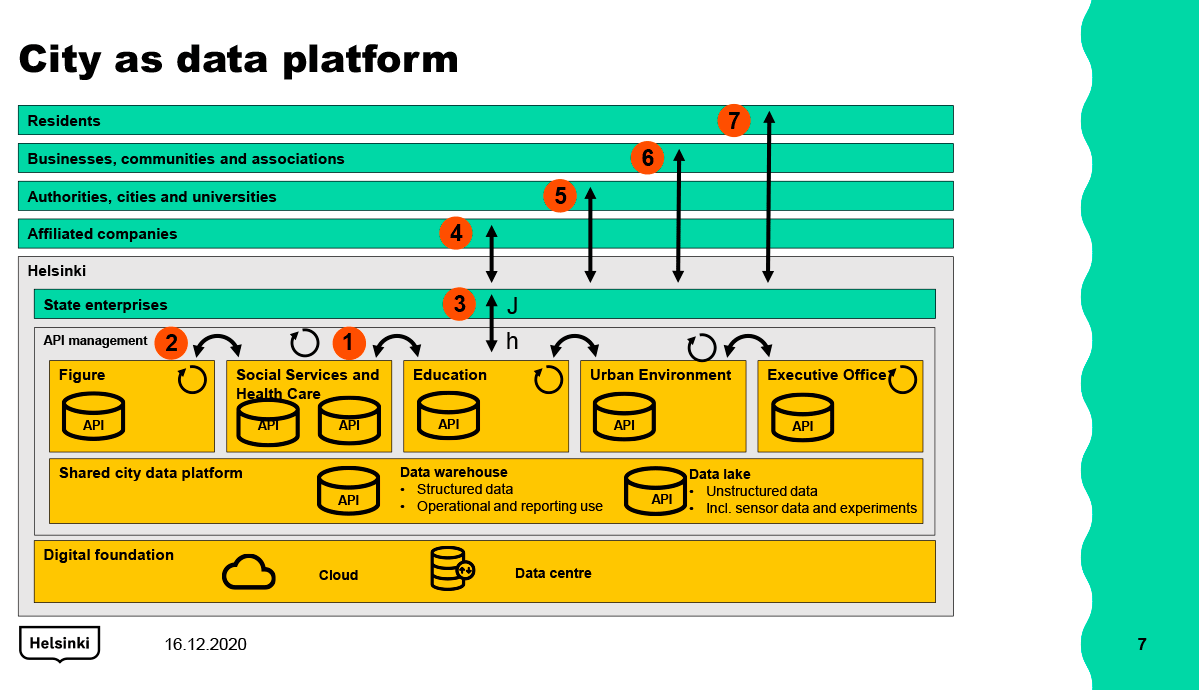2.1. The data ecosystem surrounding the city
An ecosystem means a flexible system in which communities, people, services and technologies are interlinked via natural customer needs. In this kind of ecosystem, all operators contribute to each other’s operations, benefiting from mutual cooperation. One of the objectives of the Helsinki City Strategy is to make Helsinki into the most progressive public sector ecosystem in the world.
Figure 2 illustrates Helsinki’s role as a data platform in the ecosystem operating around the city. The city’s ecosystem can be considered to include the following parties:
- city residents, people who work in the city and tourists
- companies: service providers, startups, large corporations
- communities: MyData, Open Street Map, etc.
- City divisions: the Education Division, the Urban Environment Division, the Social Services and Health Care Division (+ the City Executive Office)
- municipally owned companies and agencies: Palke, Talpa, Stara, Tyhe, Helsinki City Transport, Audit Department
- group companies that the City has control over, such as Helen and Forum Virium Helsinki
- other authorities and cities: government agencies and ministries and other cities
- universities and research institutes: universities, universities of applied sciences.
The City’s aim is for all City divisions to be equally capable of producing and utilising data across division boundaries. The Urban Environment Division and the City Executive Office have a special role in the production and sharing of City-wide data between divisions. The bottom part of the figure illustrates a City-wide data platform naturally built upon the digital foundation, which includes the City’s network, data centre and cloud solutions.
The broader goal of the Data Strategy is for data to also create opportunities for external operators to develop new services and innovations. To this end, the City wants to provide a successful platform on which companies can carry out business operations and other economic activities. The City also has a duty to increase the preconditions for community engagement, in recognition of which opening up data and the source code of algorithms and openly offering development methods to the ecosystem are essential parts of the City’s Data Strategy. These measures will allow companies and organisations to use the City’s open data and, within agreed-upon boundaries, the City’s other data as well, to develop services for residents. The City will also offer data to non-commercial parties, such as NGOs, which will allow them to develop their own operations and thus serve the residents of Helsinki while also increasing the appeal of Helsinki among visitors. As a public utility operator, the City is well-positioned to build a data ecosystem for various operators in a way that benefits all parties. In addition to utilising its own data, the City will also strive to actively utilise data that is produced elsewhere.
Figure 2. Helsinki as a data platform in the surrounding ecosystem
The blue arrows in Figure 2 illustrate seven different ways of sharing and utilising data within the City and with external parties. Each arrow is bidirectional: the City both shares its own data (s) and utilises data produced by others (u). The aim has been to identify all the different ways that should be kept separate for either technical or legislative reasons:
1. Within divisions
- register boundaries limit the sharing of information within divisions as well
- information management and data protection legislation.
2. Between divisions
- City-wide solutions needed.
3. With municipally owned companies
4. With group companies
- strategic partners to the City through ownership.
5. With the authorities, other cities and universities
- PSI Directive, information management, etc. legislation
- information retrieval from registers maintained by the authorities (the Population Information System, the Business Information System, the Land Information System)
- research permits.
6. With companies, organisations and communities
- PSI Directive, competition, etc. legislation
- data monetisation.
7. With city residents
- data protection legislation
- MyData principles.
The City of Helsinki’s data ecosystem will also support ecosystems that extend beyond city boundaries. These data ecosystems can cover all of Finland and later extend across Europe. Related to this, the European Commission’s data strategy white paper[1] from February 2020 sets the goal of creating common European data spaces by defining a regulatory framework for data management, access rights and the utilisation of data between companies, between companies and the public sector and between different public sector operators. The City of Helsinki will serve as one of the frontrunners in Europe in the building of this regulatory data management framework and the creation of a living data ecosystem.
[1] European Commission: A European Strategy for Data. White Paper. 19 February 2020.
